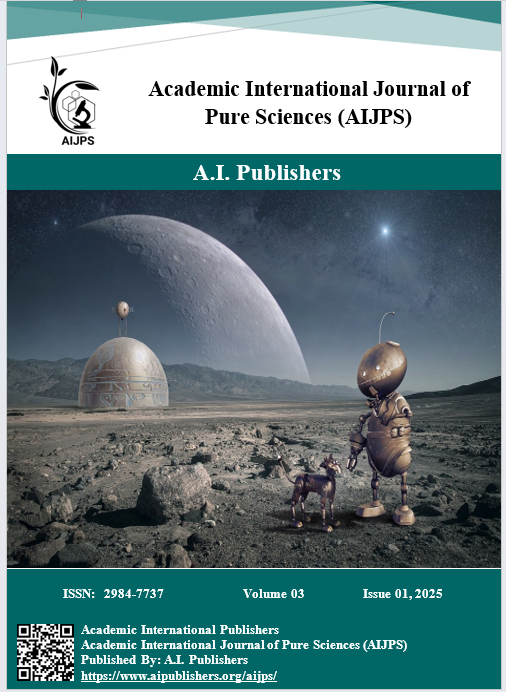Detection Of Stx1gene, Stx2 Gene and Flich7 Gene Shiga Toxin of Escherichia Coli Isolated from Human and Chickens in Karbala City
DOI:
https://doi.org/10.59675/P112Keywords:
E. coli, stx1gene, stx2 gene, Shiga toxinAbstract
Aims: This study was conducted to isolate and identify by PCR analysis for presence of stx1gene, stx2 gene and fliCh7 gene of Shiga toxin Escherichia coli from broiler chickens and humans from live chicken markets in different areas of Karbala.
Material and methods: A total of 200 fecal samples were collected from chicken broiler (n=150) and human (n=50). E. coli were isolated and identified by cultural, biochemical, Api-20E, VITEK 2 system and PCR.
Results: 13 Human and chicken positive samples include 10% , 5.3% and were derived from human and broiler chickens respectively that diagnosis by using PCR analysis for presence stx1gene, stx2 gene and fliCh7 gene. Shiga toxin-producing E. coli results negative stx1gene and positive stx2 gene .
Conclusion: Considering the findings of this study demonstrate that the chicken's digestive track hosts a bacterial pathogen, indicating that interferences are required to reduce Shiga-toxin-producing Escherichia coli (STEC) transmission.
References
Castro VS, Carvalho RCT, Conte-Junior CA, Figuiredo EES. Shiga-toxin producing Escherichia coli: pathogenicity, supershedding, diagnostic methods, occurrence, and foodborne outbreaks. Compr Rev Food Sci Food Saf. 2017;00.
Ori EL, Takagi EH, Andrade TS, Miguel BT, Cergole-Novella MC, Guth BEC, Hernandes RT, Dias RCB, et al. Diarrhoeagenic Escherichia coli and Escherichia albertii in Brazil: pathotypes and serotypes over a 6-year period of surveillance. Epidemiol Infect. 2018;147(e10):1-9.
Sarba EJ, Kelbesa KA, Bayu MD, Gebremedhin EZ, Borena BM, Teshale A. Identification and antimicrobial susceptibility profile of Escherichia coli isolated from backyard chicken in and around Ambo, Central Ethiopia. BMC Vet Res. 2019;15(1):1-8.
Ferens WA, Hovde CJ. Escherichia coli O157:H7: animal reservoir and sources of human infection.
Mingle LA, Garcia DL, Root TP, Halse TA, Quinlan TM, Armstrong LR, Chiefari AK, Schoonmaker-Bopp DJ, Dumas NB, Limberger RJ, Musser KA. Enhanced identification and characterization of non-O157 Shiga toxin-producing Escherichia coli: a six-year study. Foodborne Pathog Dis. 2012;9(11):1028-36.
Abotalp E, Abdeen E, Moustafa A, Mohamed S. Molecular detection of virulence genes of Escherichia coli O157 isolated from different sources. Alex J Vet Sci. 2017;53(2):38.
Selim SA, Ahmed SF, Aziz MHA, Zakaria AM, Klena JD, Pangallo D. Prevalence and characterization of Shiga-toxin O157 and non-O157 enterohemorrhagic Escherichia coli isolated from different sources. Biotechnol Biotechnol Equip. 2013;27(3):3834-42.
Vaziri ND, Zhao YY, Pahl MV. Altered intestinal microbial flora and impaired epithelial barrier structure and function in CKD: the nature, mechanisms, consequences, and potential treatment. Nephrol Dial Transplant. 2016;31(5):737-46.
Mandomando IM, Macete EV, Ruiz J, et al. Etiology of diarrhea in children younger than 5 years of age admitted in a rural hospital of southern Mozambique. Am J Trop Med Hyg. 2007;76(3):522-7.
Rivas M, Chinen I, Guth BEC. Enterohemorrhagic (Shiga toxin-producing) Escherichia coli. In: Torres AG, editor. Escherichia coli Diseases in the Americas. Switzerland: Springer International; 2016. p. 97-123.
Croxen MA, Law RJ, Scholz R, Keeney KM, Wlodarska M, Finlay BB. Recent advances in understanding enteric pathogenic Escherichia coli. Clin Microbiol Rev. 2013;26:822-80.
Virpari PK, Nayak JB, Thaker HC, Brahmbhatt MN. Isolation of pathogenic Escherichia coli from stool samples of diarrhoeal patients with history of raw milk consumption. Vet World. 2013;6(9):659-63.
Imen BS, Ridha M, Mahjoub A. Laboratory typing methods for diagnostic of Salmonella strains, the “old” organism that continued challenges. In: Salmonella-A Dangerous Foodborne Pathogen. 2012. p. 349-72.
Ferraro MJ. National Committee for Clinical Laboratory Standards methods for dilution antimicrobial susceptibility tests for bacteria that grow aerobically: approved standard. Wayne, PA: National Committee for Clinical Laboratory Standards; 2000. p. 36.
Niazi AD. Statistical Analysis in Medical Research. Al-Nehrien University Republic of Iraq; 2000. p. 148.
Omebije PE, Adogo LY, Ajide B. Prevalence and antibiotic susceptibility pattern of Escherichia coli 0157 associated with gastroenteritis in Minna, Niger State, Nigeria. Microbiol Res J Int. 2016;1-7.
van den Bogaard AE. Antibiotic resistance of faecal Escherichia coli in poultry, poultry farmers and poultry slaughterers. J Antimicrob Chemother. 2001;47(6):763-71.
Joseph Fuh N. Prevalence and antibiotic resistance of Escherichia coli O15 serotype from chicken droppings produced by free-ranged and poultry birds in Cross River, Nigeria. Am J Biomed Life Sci. 2018;6(3):51.
Shecho M, Thomas N, Kemal J, Muktar Y. Cloacael carriage and multidrug resistance Escherichia coli O157 from poultry farms, Eastern Ethiopia. J Vet Med. 2017;2017:1-9.
Olorunshola ID, Smith SI, Coker AO. Prevalence of EHEC O157 in patients with diarrhoea in Lagos, Nigeria. Apmis. 2000;108(11):761-3.
Klaif SF, Saleh ZF, Hussein MT, Jawad AA, Jawad MS. Molecular characterization of enterohemorrhagic E. coli O157 and O153 isolated from tissue camel and human stool samples in Al-Diwaniyah, Iraq. Iraqi J Vet Sci. 2019;33(1):81-6.
Bolukaoto JY, Kock MM, Strydom KA, Mbelle NM, Ehlers MM. Molecular characteristics and genotypic diversity of enterohaemorrhagic Escherichia coli O157 isolates in Gauteng region, South Africa. Sci Total Environ. 2019;692:297-304.
Olatoye IO, Amosun EA, Ogundipe GAT. Multidrug-resistant Escherichia coli O157 contamination of beef and chicken in municipal abattoirs of southwest Nigeria. Nat Sci. 2012;10(8):125-32.
Alalade OM, Ameh JB, Abdullahi IO, Whong CMZ. Screening for virulence genes in Escherichia coli O157 obtained from drinking water from Ikara, Kaduna state, Nigeria. Ife J Sci. 2018;20(1):139.
Fard AHM, Bokaeian M, Qureishi ME. Frequency of Escherichia coli O157 in children with diarrhoea in Zahedan, Islamic Republic of Iran. East Mediterr Health J. 2008;14(5):1022-7.






